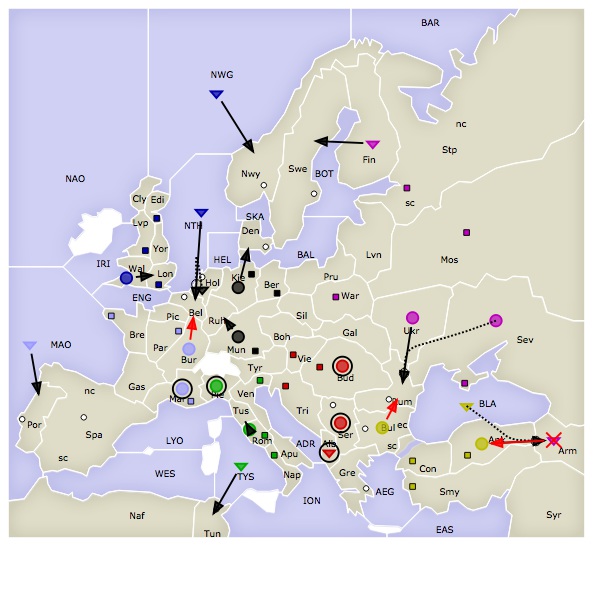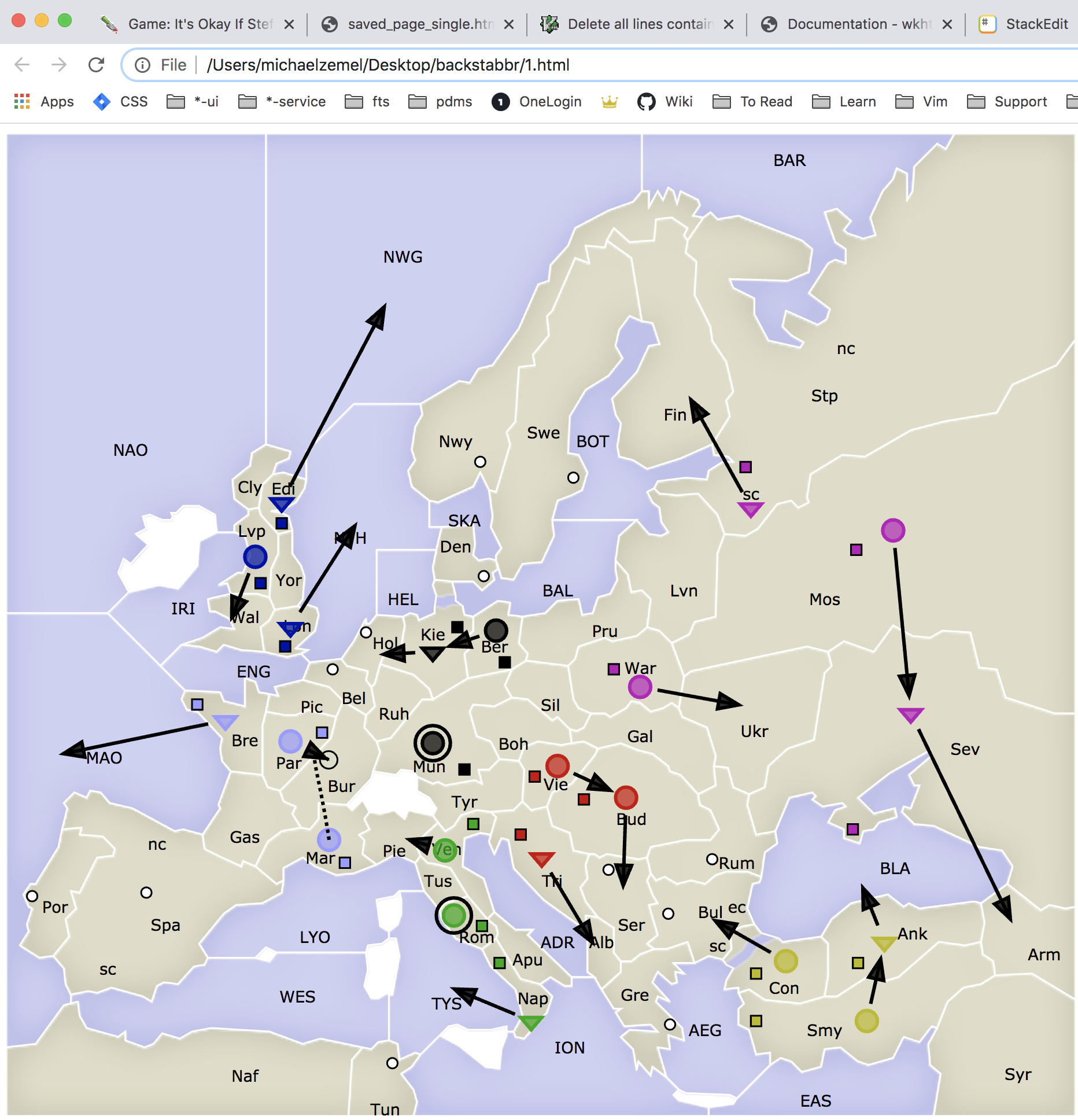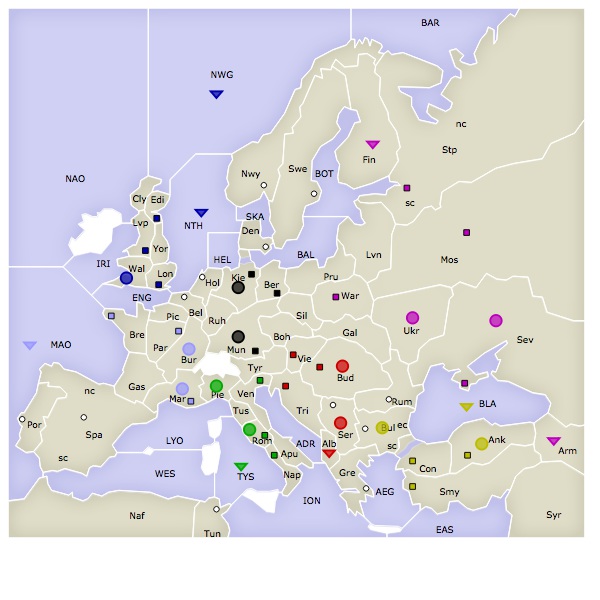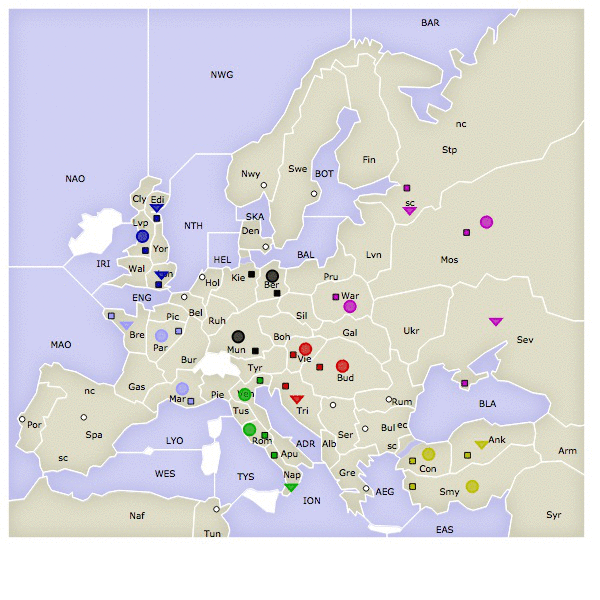Backstabbr GIFs
Click here to see the finished GIF
I love playing Diplomacy on Backstabbr.
Recently, I played a really fun game where I tried to solo in 1905, and everyone rallied together to stop me. It was a give-and-take chase across Europe for the next 15 years, leading to my eventual defeat in Winter of 1920.
What I really wanted - besides to know what my opponents were saying about me - was to see the game as a GIF.
Now, I could go back to previous turns and screenshot them all, crop the images, and create a GIF, but on every previous page Backstabbr always overlays the red and black “order resolutions” on the map.

While that is an integral part of the GIF, I also wanted to show the state of the open board each turn, before orders were resolved. This would show more clearly the position players were in, as well as convey a period of careful planning and strategy before entering orders.
So how would I do this?
Since the map on the page is an <SVG>, my plan was to take the page’s HTML, remove all the order resolution elements, and have an image of the pre-resolution state.
Getting the HTML
My first step was saving what I saw in View Source (⌘⌥u on Mac).
I quickly learned, however, that View Source is NOT the same as Inspect Element.
View Source will give you the HTML document provided by the server (available through the Sources tab in the Chrome DevTools).
Inspect Element looks at HTML that has been modified by CSS and Javascript. Because Backstabbr was using Javascript to draw the SVG in the browser, it did not appear in View Source.
I could not find an “easy way” to download the Inspect Element HTML. Maybe I missed it, because the way I ended up doing it felt pretty long.
I decided to Save the page and was given two options, Save page (complete) and Save page (single file).
Save page (complete)
“Complete”, I thought. I unzipped the download, and was given two items:
backstabbr.htm
backstabbr_files/
all.min.css
jquery.min.css
...
As you can see, this downloads every externally hosted asset. In the .htm file there are relative paths for all assets:
<link href="./backstabbr_files/bootstrap.min.css" rel="stylesheet" integrity="..." crossorigin="...">
I tried swapping out the relative path for an absolute one, https://www.backstabbr.com/bootstrap.min.css, but – in retrospect, obviously – that’s not where the files are hosted..
Given I can’t go through every assets and infer where it’s from (I guess I could if I reallllly had to), I decided to take another route.
Save page (single file)
Ah, ha! I thought. This must be it.
I downloaded the page as a single file and was given a file with an .mhtml extension.
I open it up in my text editor and notice some really strange stuff:
From: <Saved by Blink>
Snapshot-Content-Location: https://www.backstabbr.com/game/Its-Okay-If-Stefon-Loses/6301224099381248/1918/spring
Subject: Game: It's Okay If Stefon Loses | spring 1918 | Backstabbr
Date: Sat, 13 Jun 2020 23:00:51 -0000
MIME-Version: 1.0
Content-Type: multipart/related;
type="text/html";
boundary="----MultipartBoundary--CnhE2y0UIwz7apsP21ksjv9bp07FgmYYC4sjAfKWZe----"
------MultipartBoundary--CnhE2y0UIwz7apsP21ksjv9bp07FgmYYC4sjAfKWZe----
Content-Type: text/html
Content-ID: <[email protected]>
Content-Transfer-Encoding: quoted-printable
Content-Location: https://www.backstabbr.com/game/Its-Okay-If-Stefon-Loses/6301224099381248/1918/spring
<!DOCTYPE html><html lang=3D"en"><head><meta http-equiv=3D"Content-Type" co=
ntent=3D"text/html; charset=3DUTF-8">
<link rel=3D"manifest" href=3D"https://www.backstabbr.com/manifest.json">
<meta http-equiv=3D"X-UA-Compatible" content=3D"IE=3Dedge">
<meta name=3D"keywords" content=3D"diplomacy,diplomacy game,online diplom=
So before we get to the actual HTML, there are some headers. And as I scrolled down, I noticed a LOT of encoded data:
9 ------multipartboundary--cnhe2y0uiwz7apsp21ksjv9bp07fgmyyc4sjafkwze----
8 content-type: font/woff2
7 content-transfer-encoding: base64
6 content-location: https://fonts.gstatic.com/s/lato/v16/s6uyw4bmutphjx4wxiwtfcc.woff2
5
4 d09gmgabaaaaadbcaa0aaaaabvgaadafaaeaaaaaaaaaaaaaaaaaaaaaaaaaaaaag6r6hhagyacb
3 rbemcogeaigdggudqgabngika4z2bcafhrghheubgf5fb2lgoadmhpynoh7iucjihg2qk7zk/58t
2 1biyf+sack5uubhuvqz8zaqfogmuvz7uvu93ltbfg9z2punpgz+vgx9huymbumvwljtzr2kx0xwj
1 f+4zxgbqzn65+5ktjcnmgxlmb6bzmpb4vui6a9xhryw7d+v+/57djpd94jilmqiojy0haocayfzv
11715 ybpritaehkngh/zxb2ybpn07n7dtiuko7tqibc8udwn+q+c2zps0hascqigokaicg3exlrblihmb
I had no idea what this was. The M in MHTML stands for MIME, but this is a webpage, not mail. My guess is that mail is involved in the file download, perhaps Chrome “sending” it to your computer.
I tried a different browser, Firefox, but got the same thing. Ultimately, though, my <SVG> element was in there!
Changing the SVG
Unfortunately, due to the MIME artifacts, the SVG was a little mangled:
<div id=3D"map"><svg height=3D"100%" version=3D"1.1" width=3D"99%" xmlns=
=3D"http://www.w3.org/2000/svg" style=3D"overflow: hidden; position: relati=
ve; left: -0.5px;" viewBox=3D"0 0 610 560" preserveAspectRatio=3D"xMinYMin"=
><desc style=3D"-webkit-tap-highlight-color: rgba(0, 0, 0, 0);">Created wit=
...
That’s ok!
I used a couple regexes (s/=\n//g, s/3D//g) to get the <SVG> element on a single line,
… then :g!/.*<svg/d to delete all other lines,
… then s/<\/\(\w*\)>/<\/\1>\r/g to put each SVG element on its own line,
… then put the <svg> inside an <html> and <body>,
…and changed the file extension to .html
Viola!

Sample SVG lines, for illustration:
<path fill="#dfddc9" stroke="#ffffff" d="M192,323L205,331L204,338L211,346L213,352L209,363L208,367L194,382L178,381L178,390L173,396L168,395L163,387L165,383L158,380L156,374L165,365L185,344L188,332Z" fill-opacity="0" stroke-width="1" transform="matrix(1,0,0,1,0,0)" id="ter_Bur" style="-webkit-tap-highlight-color: rgba(0, 0, 0, 0); fill-opacity: 0;"></path>
<text x="246" y="425" text-anchor="middle" font="10px "Arial"" stroke="none" fill="#000000" style="-webkit-tap-highlight-color: rgba(0, 0, 0, 0); text-anchor: middle; font: 9px Verdana; fill-opacity: 1;" font-family="Verdana" font-size="9px" fill-opacity="1" transform="matrix(1,0,0,1,0,0)"><tspan dy="3.609375" style="-webkit-tap-highlight-color: rgba(0, 0, 0, 0);">Tus</tspan>
At this point, I have an .html file with order resolutions.
Using variations on :g/<path.*#000000/d, I erased black and red <circle>s and <path>s.
This leaves me with exactly what I want:

Converting to a JPG
From searching, it looks like people recommend wkhtmltoimage, the less-documented, red-headed step-child of wkhtmltopdf.
I was getting some weird errors, which turned out to be a 3-hour-old issue.
dyld: lazy symbol binding failed: Symbol not found: ____chkstk_darwin
Referenced from: /usr/local/bin/wkhtmltoimage
Expected in: /usr/lib/libSystem.B.dylib
So I grabbed an earlier release, and used:
wkhtmltoimage --height 600 --width 600 backstabbr.html backstabbr.jpg
To create a series of images, I created the following script:
for i in {1..51}
do
vim $i.mhtml -c '%s/=\n//g | %s/3D//g | wq'
sed -n '/^.*<svg/p' $i.mhtml > $i.html
vim $i.html -c '%s/<\/\(\w*\)>/<\/\1>\r/g | %s/<div id="map">/<html><body>/ | %s/\/images\/map/https:\/\/www.backstabbr.com\/images\/map/ | wq'
echo "</body></html>" >> $i.html
sed -i '' '/<path fill="#000000" stroke="#000000.*stroke-width="0"/d' $i.html
wkhtmltoimage --height 600 --width 600 $i.html image$((i*2)).jpg
sed -i '' '/<path fill="none" stroke="#000000/d' $i.html
sed -i '' '/<path fill="#000000" stroke="#000000.*stroke-width="2"/d' $i.html
sed -i '' '/<path.*#ff0000/d' $i.html
sed -i '' '/<path.*#ffa500/d' $i.html
sed -i '' '/<circle.*fill="none" stroke="#000000/d' $i.html
sed -i '' '/<circle.*fill="none" stroke="#ff0000/d' $i.html
wkhtmltoimage --height 600 --width 600 $i.html image$((i*2 - 1)).jpg
done
I can’t say that this part was fun. But it is done.
I then used ImageMagick to convert the stills into a GIF with:
convert -delay 1x2 -loop 0 *.jpg -coalesce -layers OptimizeTransparency backstabbr.gif
Finished GIF


